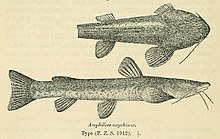| Loach catfishes | |
|---|---|

| |
| Amphilius grandis | |
| Scientific classification | |
| Domain: | Eukaryota |
| Kingdom: | Animalia |
| Phylum: | Chordata |
| Class: | Actinopterygii |
| Order: | Siluriformes |
| Superfamily: | Loricarioidea |
| Family: | Amphiliidae Regan, 1911 |
| Genera | |
|
Subfamily Amphiliinae | |
The loach catfishes are a family, Amphiliidae, of catfishes (order Siluriformes). They are widespread in tropical Africa, but are most common in streams at high elevations; most species are able to cling to rocks in fast-flowing streams.[2] The 13 genera contain 68 species.
The family Amphiliidae has three subfamilies, Amphiliinae, Leptoglanidinae (previously misspelled Leptoglaninae), and Doumeinae.[3] The monophyly of Amphiliidae has been questioned; one author restricts the family to the members of the subfamily Amphiliinae and transferred the other genera to a family Doumeidae.[3] The Amphiliidae have been previously thought to be a basal taxon in the superfamily Loricarioidea, but some authors place their relationships elsewhere.[2][4]
- ^ Ferraris, C.J. Jr., Vari, R.P. & Skelton, P.H. (2011): A new genus of African loach catfish (Siluriformes: Amphiliidae) from the Congo River basin, the sister-group to all other genera of the Doumeinae, with the description of two new species. Copeia, 2011: 477–489.
- ^ a b Nelson, Joseph S. (2006). Fishes of the World. John Wiley & Sons, Inc. ISBN 0-471-25031-7.
- ^ a b Ferraris, Carl J. Jr. (2007). "Checklist of catfishes, recent and fossil (Osteichthyes: Siluriformes), and catalogue of siluriform primary types" (PDF). Zootaxa. 1418: 1–628. doi:10.11646/zootaxa.1418.1.1. Retrieved 2009-06-25.
- ^ Sullivan, JP; Lundberg JG; Hardman M (2006). "A phylogenetic analysis of the major groups of catfishes (Teleostei: Siluriformes) using rag1 and rag2 nuclear gene sequences". Mol Phylogenet Evol. 41 (3): 636–662. doi:10.1016/j.ympev.2006.05.044. PMID 16876440.